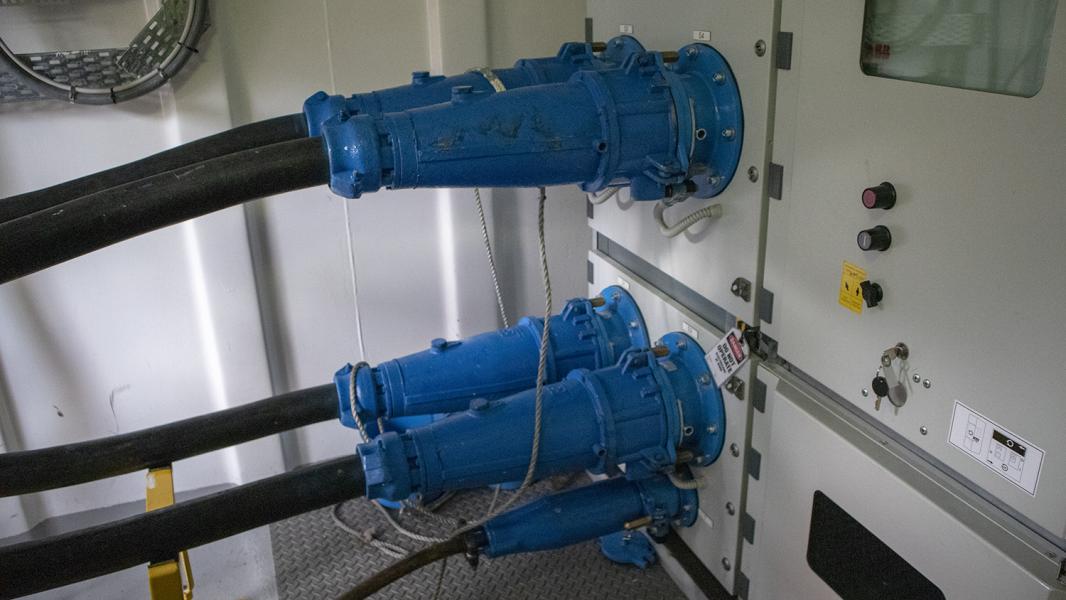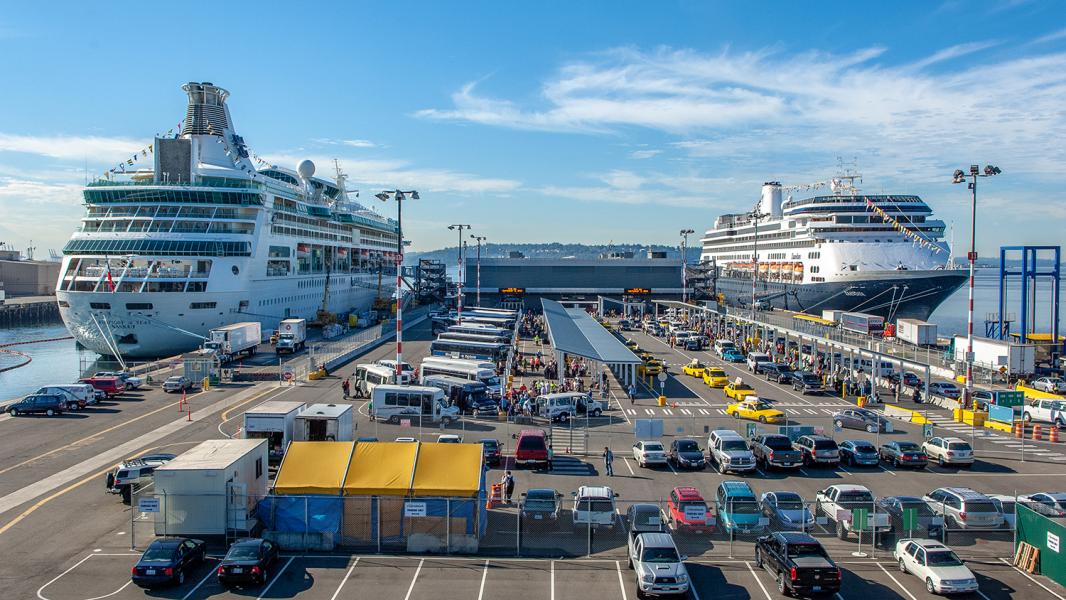When the Port of Seattle kicked off plans to develop a new cruise ship facility on the Seattle waterfront, we were faced with a challenge.
Port leaders knew from more than a decade of experience at Terminal 91 that connecting docked cruise ships to clean, landside electrical power while they unload and reload the ship helps protect air quality and reduce harmful emissions.
But traditional efforts to link additional berths like Pier 66 and the future Terminal 46 berth to city-owned electrical grids with sufficient power would require tearing up roads and waterfront to lay cables.
The Port has long prioritized protecting the environment, with the goal to reduce greenhouse gases and be carbon neutral by 2050. With a commitment to clean energy and a growing opportunity to expand the cruise industry in Seattle, project leaders went back to the drawing board in their search for a cost-effective alternative.
A recent feasibility study showed that placing a submarine cable starting at Terminal 46 — essentially a large waterproof extension cord — could successfully bring clean energy to the Pier 66 terminal at a fraction of the cost of cables buried under city streets.
Submarine cables, which are electrical cables laid on seabeds, brought cost-effective, clean energy solutions to many other parts of the world facing similar challenges. One local example is Orcas Power and Light Co-Op’s installation of 13,596 feet of submarine cable between Lopez and San Juan Islands in 2017.
The history of cruising in Seattle
Seattle has been welcoming the cruise ship industry as a home port for 20 years. Cruise itineraries between Seattle and Alaska began in May 2000 with a long-term commitment from Norwegian Cruise Line. Seattle’s cruise business has grown every year since. Each home port ship call contributes an average of $4.2 million to the state’s economy and supports more than 5,500 jobs, according to the Port’s 2019 Economic Impact of Cruise Study by Community Attributes.
“In two decades, cruise ships went from being a summertime novelty to supporting nearly $900 million in annual economic activity,” said Port of Seattle Commissioner Stephanie Bowman. “Now communities that are here — and even hundreds of miles away — benefit from cruise through tourism spending and by selling Washington beer, wine, and food to cruise companies.”
There’s an abiding commitment to safeguarding the environment in Seattle. It’s the only home port in North America with a voluntary clean water agreement with the cruise lines and regulators. Beyond compliance, the Port also works closely with the industry to minimize the air quality impacts of cruise ship exhaust. As a result, greenhouse gas emissions and diesel pollution from oceangoing vessels visiting the Port of Seattle, including cruise ships, have decreased by more than 20 percent and 82 percent respectively over the past 10 years, according to an emissions study by the Puget Sound Maritime Air Forum.
The Holland America Group, including Princess Cruises and Holland America Line, was instrumental in establishing shore power for cruise ships in Seattle in 2004 at the former Terminal 30 cruise facility.

A day in the life of a cruise ship
Each time a cruise ship docks in Seattle, it takes an average of 10 hours to offload guests, load provisions, welcome new guests on board, and prepare for its next departure. Last year, ships at Terminal 91, for example, spent nearly 300 hours at dock while its passengers explored the city.
While the ships are at berth, they still need energy to run lights, chill food, operate equipment, and power myriad other onboard services. Berths without electrical options use fuel-powered engines to keep the ships operating. At Terminal 91, many ships instead connect to shore power via an oversized electrical plug. An average cruise ship plugging into shore power at Terminal 91 saves the greenhouse gas equivalent of a typical car driving 30 road trips from Seattle to New York, according to the Port.
The Port of Seattle was the first home port in North America to offer shore power at two berths. “We look beyond what the regulations require and embrace a mindset to be the most environmentally progressive home port in North America,” Bowman said. Case in point: The electrical shore power system put in place at Terminal 91 in 2009 has since been replicated at other ports around the world.
The long-time success of shore power at Terminal 91 is the reason we're excited about bringing electrical power to existing and future cruise ship berths. While landside delivery of electrical power to the existing Pier 66 could require placement of large duct banks and vaults under nearby streets, the proposed submarine cable placement alternatives would reduce the cost and eliminate the disruption of street right-of-way.
Laying approximately a mile of underwater cable would likely take less than a week, compared with months required to install duct banks, vaults, and cables in street right of way, according to Port Project Manager Fred Chou. The power supply to this submarine cable is envisioned to connect to the city grid at the same location as the proposed shore power service for Terminal 46. There will be shore power connectivity for shore-power-capable cruise ships at four cruise vessel berths once the Pier 66 and Terminal 46 projects are complete.

Continuing commitment to the environment — waterfront electrification
“With 20 acres of new parks and infrastructure now beginning construction, Seattle’s central waterfront is entering a new era,” said Marshall Foster, Director of the City of Seattle’s Office of the Waterfront and Civic Projects. “Those of us working on the waterfront have long shared a commitment to environmental and community health. The Port’s focus on clean energy complements the City’s investments in restoring shoreline habitat and improving public access to Elliott Bay, and will reduce carbon emissions and improve air quality.”
With the electrification of the Port of Seattle’s waterfront terminals, we're taking our environmental commitment a step further. We're looking to the future and laying the groundwork to upgrade the harbor electricity grid to provide clean energy to Seattle’s working waterfront – not only for shore power to all cruise berths, but for container cargo berths too. The goal is to identify infrastructure investments over the next 30 years that provide sufficient clean energy for shore power, cargo handling equipment, and for the drayage trucks that will benefit from substituting low emission electricity for burning fossil fuels. Each solution will be evaluated on its ability to reduce emissions, be affordable, and provide resilient energy in face of catastrophic events, all while being reliable.
New state laws provide further momentum for efforts to expand electrification on Seattle’s working waterfront. Washington state recently enacted a clean energy bill which requires the state’s use of 100 percent clean energy by 2045. The legislation also includes a provision to help the state meet that goal by funding “energy transformation projects,” or projects that help utility customers reduce the consumption of fossil fuels. Additional legislation gives public utilities in the state clear authority to make investments in transportation electrification.
These developments open new doors to local leaders committed to expanding clean energy to Seattle’s waterfront.
Originally published in Crosscut






